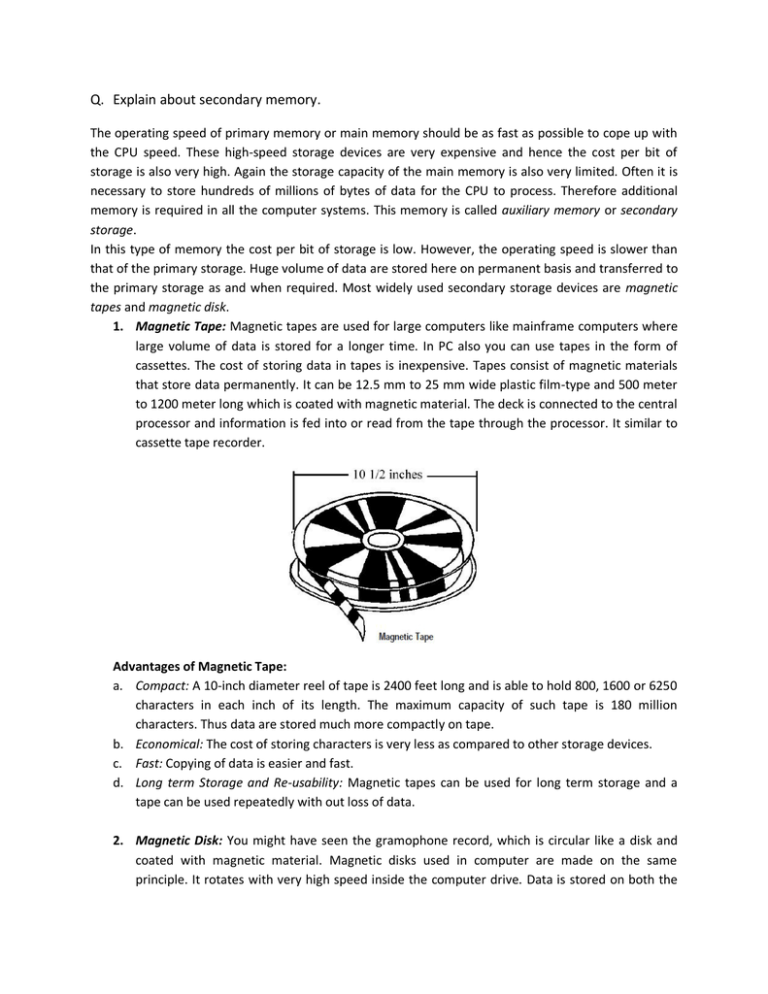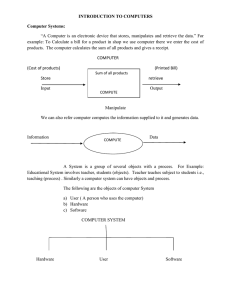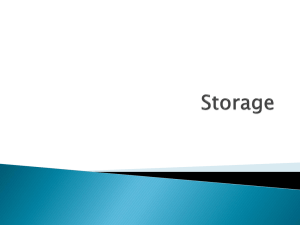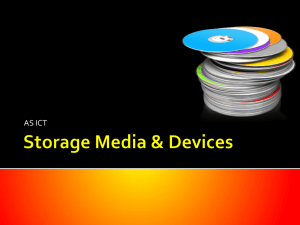Q. Explain about secondary memory.
advertisement

Q. Explain about secondary memory. The operating speed of primary memory or main memory should be as fast as possible to cope up with the CPU speed. These high-speed storage devices are very expensive and hence the cost per bit of storage is also very high. Again the storage capacity of the main memory is also very limited. Often it is necessary to store hundreds of millions of bytes of data for the CPU to process. Therefore additional memory is required in all the computer systems. This memory is called auxiliary memory or secondary storage. In this type of memory the cost per bit of storage is low. However, the operating speed is slower than that of the primary storage. Huge volume of data are stored here on permanent basis and transferred to the primary storage as and when required. Most widely used secondary storage devices are magnetic tapes and magnetic disk. 1. Magnetic Tape: Magnetic tapes are used for large computers like mainframe computers where large volume of data is stored for a longer time. In PC also you can use tapes in the form of cassettes. The cost of storing data in tapes is inexpensive. Tapes consist of magnetic materials that store data permanently. It can be 12.5 mm to 25 mm wide plastic film-type and 500 meter to 1200 meter long which is coated with magnetic material. The deck is connected to the central processor and information is fed into or read from the tape through the processor. It similar to cassette tape recorder. Advantages of Magnetic Tape: a. Compact: A 10-inch diameter reel of tape is 2400 feet long and is able to hold 800, 1600 or 6250 characters in each inch of its length. The maximum capacity of such tape is 180 million characters. Thus data are stored much more compactly on tape. b. Economical: The cost of storing characters is very less as compared to other storage devices. c. Fast: Copying of data is easier and fast. d. Long term Storage and Re-usability: Magnetic tapes can be used for long term storage and a tape can be used repeatedly with out loss of data. 2. Magnetic Disk: You might have seen the gramophone record, which is circular like a disk and coated with magnetic material. Magnetic disks used in computer are made on the same principle. It rotates with very high speed inside the computer drive. Data is stored on both the surface of the disk. Magnetic disks are most popular for direct access storage device. Each disk consists of a number of invisible concentric circles called tracks. Information is recorded on tracks of a disk surface in the form of tiny magnetic spots. The presence of a magnetic spot represents one bit and its absence represents zero bit. The information stored in a disk can be read many times without affecting the stored data. So the reading operation is non-destructive. But if you want to write a new data, then the existing data is erased from the disk and new data is recorded. 3. Floppy Disk: It is similar to magnetic disk discussed above. They are 5.25 inch or 3.5 inch in diameter. They come in single or double density and recorded on one or both surface of the diskette. The capacity of a 5.25-inch floppy is 1.2 mega bytes whereas for 3.5 inch floppy it is 1.44 mega bytes. It is cheaper than any other storage devices and is portable. The floppy is a low cost device particularly suitable for personal computer system. 4. Optical Disk: With every new application and software there is greater demand for memory capacity. It is the necessity to store large volume of data that has led to the development of optical disk storage medium. Optical disks can be divided into the following categories: a. Compact Disk/ Read Only Memory (CD-ROM): CD-ROM disks are made of reflective metals. CD-ROM is written during the process of manufacturing by high power laser beam. Here the storage density is very high, storage cost is very low and access time is relatively fast. Each disk is approximately 4 1/2 inches in diameter and can hold over 600 MB of data. As the CD-ROM can be read only we cannot write or make changes into the data contained in it. b. Write Once, Read Many (WORM): The inconvenience that we can not write any thing in to a CD-ROM is avoided in WORM. A WORM allows the user to write data permanently on to the disk. Once the data is written it can never be erased without physically damaging the disk. Here data can be recorded from keyboard, video scanner, OCR equipment and other devices. The advantage of WORM is that it can store vast amount of data amounting to gigabytes (109 bytes). Any document in a WORM can be accessed very fast, say less than 30 seconds. c. Erasable Optical Disk: These are optical disks where data can be written, erased and rewritten. This also applies a laser beam to write and re-write the data. These disks may be used as alternatives to traditional disks. Erasable optical disks are based on a technology known as magnetic optical (MO). To write a data bit on to the erasable optical disk the MO drive's laser beam heats a tiny, precisely defined point on the disk's surface and magnetises it.






